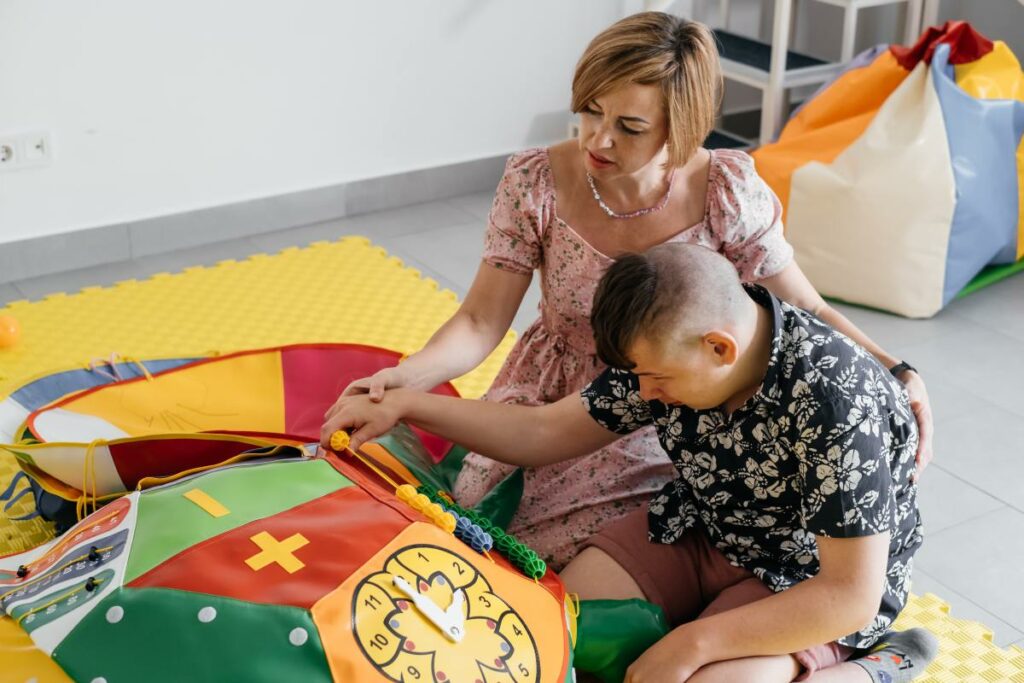Did you know that one in six people have a sensory issue? That’s a lot of people! Sensory inclusive environments are becoming more and more common as we realize the importance of accommodating everyone. In this article we will discuss inclusive sensory environments and how you can promote and support them in your community.

What Is A Sensory Inclusive Environment?
An inclusive sensory environment has been designed to be welcoming and accommodating for all people, regardless of their sensory needs. This can include sound-dampening materials, low-lighting, and comfortable seating. Sensory inclusive environments are essential for people with autism spectrum disorder (ASD) because they can help reduce overstimulation and anxiety.
In many cases medical professionals say heightened sensitivities characterize ASD to light, sound, and touch. As a result, traditional environments can be overwhelming and often trigger negative behaviors. However, in an inclusive sensory climate, people with ASD can feel more relaxed and comfortable, reducing the likelihood of disruptive behaviors. In addition, inclusive sensory environments can help promote social inclusion and communication. By removing some of the barriers that often exist for people with ASD, these environments can help to create a more inclusive society for all.
What Are Some Characteristics Of Sensory Inclusive Environments?
There are a few key characteristics that all-inclusive sensory environments share. First, they are designed to be welcoming for all people, regardless of their sensory needs. The domain has been specifically tailored to reduce overstimulation and anxiety. Second, sensory-inclusive environments often have sound-dampening materials to reduce noise levels. Low-lighting is also common in these environments, as it can help to reduce visual stimulation. Finally, comfortable seating is often provided to allow people to relax and feel comfortable.
How Can You Promote Sensory Inclusive Environments?
Experts say there are a few ways that you can promote sensory-inclusive environments in your community or workplace. First, you can educate others about the importance of these environments. This can be done through presentations, workshops, or casual conversation. It is essential that people understand the need for these environments and how they can benefit those with ASD.
Second, you can advocate for including inclusive sensory features in public places. This can be done by contacting your local representatives or writing to businesses and organizations. Finally, you can support companies and organizations that are already sensory-inclusive. This can be done by patronizing their services and spreading the word about their commitment to inclusion.
What Are Some Ways To Support People With ASD In Sensory Inclusive Environments?
There are a few ways that you can support people with ASD in inclusive sensory environments. First, you can educate yourself about ASD and become familiar with the challenges that people with this condition face. This will help you be more understanding and patient when interacting with someone with ASD.
Second, you can be an advocate for inclusive environments. It means speaking up when you see places that could be more accommodating and support already sensory-inclusive businesses. Finally, you can help people with ASD and their families/caregivers. This can be done by offering assistance or simply being a listening ear.
Are Any Challenges Associated With Promoting And Supporting Sensory Inclusive Environments For People With ASD And Their Families/Caregivers?
A few challenges are associated with promoting and supporting inclusive sensory environments for people with ASD and their families/caregivers. First, there is a lack of awareness about ASD and its effects. This means that many people are not familiar with the challenges that people with ASD face. As a result, they may not understand the need for inclusive sensory environments.
Second, there is a lack of inclusion in public places. This can be a barrier for people with ASD and their families/caregivers, limiting their access to necessary services and support. Finally, there is a lack of support for businesses and organizations that are already sensory-inclusive. This can make it difficult for these businesses to sustain their commitment to inclusion.
What Is The Future Of Sensory Inclusive Environments?
The future of inclusive sensory environments is promising. As more people become aware of ASD and its effects, there will be greater demand for these environments. This will lead to more businesses and organizations incorporating inclusive sensory features into their facilities. As a result, people with ASD and their families/caregivers will have greater access to the support and accommodations they need.
However, professionals say some challenges still need to be addressed to make inclusive sensory environments more widely available. First, there is a need for more education about ASD and its effects. This will help to increase understanding and acceptance of these environments. Second, there is a need for more inclusion in public places. This can be done by increasing the number of sensory-inclusive businesses and organizations. Finally, more support is needed for companies and organizations already sensory-inclusive. This can be done by raising awareness of these businesses and providing financial support.
By addressing these challenges, we can create a more inclusive world for people with ASD and their families/caregivers. Sensory inclusive environments provide the support and accommodations that they need to participate in everyday activities. By promoting and supporting these environments, we can positively impact the lives of those with ASD.
Final Thoughts
Sensory inclusive environments are essential for people with ASD and their families/caregivers. These environments provide the support and accommodations that they need to participate in everyday activities. By promoting and supporting these environments, we can positively impact the lives of those with ASD.



